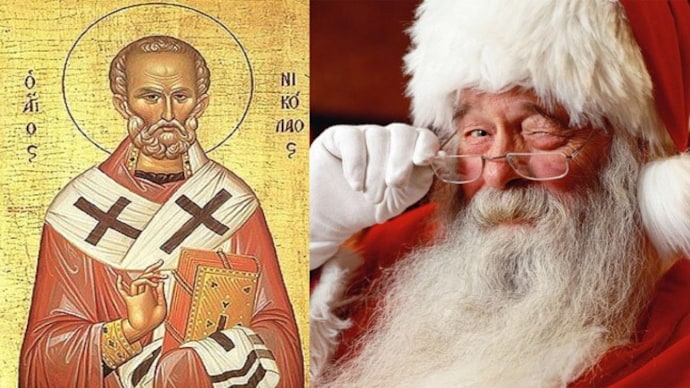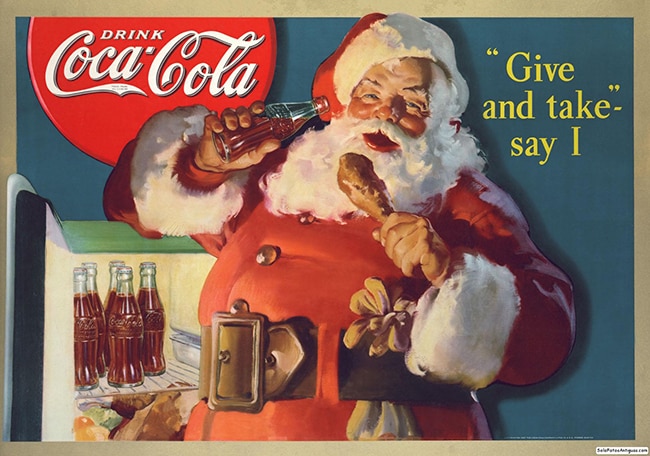From St Nicholas to Santa Claus: How a 4th century Greek Bishop transformed into the Christmas icon after 1500 years
Santa went through many changes as Christmas celebrations transformed over the years.

Santa Claus has been associated with Christmas for quite a long time and in this day and age, probably no one can think of the holiday without thinking of the jolly old man with a white beard and a red suit who secretly brings gifts for children.
But is Santa Claus a completely made-up character? He isn't. The concept of Santa, as we know him now, developed over several hundred years as the celebration of Christmas went through various changes in Europe and America.
St Nicholas, the main inspiration behind the character of Santa Claus, was born 280 years after the birth of Jesus. He was a Greek, presumably with olive-toned skin. He wasn't jolly or fat.
Instead, the man who became the Archbishop of Myra had a fiery personality and played a significant role in the Great Persecution when priests were forced to renounce Christianity and Bibles were burnt.
Born to rich parents who died in an epidemic, he was raised by his uncle, who was a bishop.

Reconstructed face of St. Nicholas doesn't look like Santa Claus
The remains of the fourth-century Greek bishop are kept in Italy. When his crypt was repaired in the 1950s, the bones and skull were measured in detail and x-ray photos were taken of them.
His face, which had a badly broken nose, was then digitally reconstructed. Olive-toned skin, grey hair and certain other details were added purely as guesswork. But he looked nothing like the Santa Claus we know.
Why he was the patron saint of children
He was the patron saint of a great many groups, but mainly of children and ships, and was a miracle worker too. The association of St Nicholas as a benefactor of children mainly began with two stories about his life.

The first story was about how he saved three girls from prostitution by giving their father three bags of gold for their dowry so that they could get married into good families. He tossed the bags through an open window one by one, secretly, and they landed inside stockings left to dry near the chimney.
After the first two times that his daughters found bags of gold inside their stockings, the father stayed up to discover who was helping them. When a bag of gold was thrown into a stocking that night, the father rushed out to find the young St Nicholas.

The second story was about three boys. It says that St. Nicholas once went to an inn where the innkeeper had murdered three boys and kept their dismembered bodies in barrels in his wine cellar. He sensed the horrific crime and even resurrected the dead children.
The generosity of the young bishop
St Nicholas obeyed the words of Jesus to "sell what you own and give the money to the poor" and used his entire inheritance to help the poor, sick and needy. He helped a large number of people in various ways and most of them are not known as he didn't spread goodwill and good favour for his own benefit or recognition.
In the East, he is revered as a miracle worker, while in the West, he is patron to several groups of people - including thieves and murderers as well.
Suffering for his faith in the Great Persecution
Under the Roman Emperor, Diocletian, Christians were persecuted in droves and the prisons were so full with priests, bishops and deacons that there wasn't space for the real criminals. Nicholas was exiled and spent years in prison before Constantine made Christianity prominent in his empire.
Nicholas' death and the mysterious 'manna'
The bishop passed away on December 6, in an unknown year in the mid-fourth century, around 343 AD. The date became St. Nicholas' Feast Day and from 1200 to 1500, the bishop and gift bringer was celebrated unchallenged with stories of his work and generosity.
During this time, the saint began to be represented with certain traits of early European gods such as Saturn or Odin who had a white beard and ensured good behaviour of children.
Yet another cause for his continued popularity is the "manna" that formed in his tomb in Myra and even in Bari, Italy where his remains were later housed. This manna is pure water and is said to have healing powers.
Saint Nicholas in the New World and Sinterklaas
When the first Europeans came to the New World of America, they brought the stories and celebrations about St. Nicholas with them. The 16th-century Protestant Reformation however ensured that saints fell out of favour of the people.
Nevertheless, it was not possible to completely stamp out the St. Nicholas-related customs in long term, except in England where the folk religious traditions were changed forever.

Around the 18th century, the Dutch colonies brought their 'Sinterklaas' and related traditions to the New World where the tales of shaggy and scary German gift bearers also endured. The character of Sinterklaas combined with the 17th century British Father Christmas and the Germanic tales and was ultimately Americanised as Santa Claus.
When Christmas was banned
The 19th century brought with it several cultural changes. Writers from New York among others wanted the Christmas holiday to be domesticated. When Christmas was eliminated as a holy season by Puritans and other Calvinists, the celebrations became very disruptive with public disorder and open drunkenness.
As the holidays gave more leisure time and less work, drunken mobs, mainly of workers and servants roamed the streets damaging property and threatening the upper class.

Christmas became akin to a pagan celebration in early America and was shunned. The observance of Christmas was seen as inconsistent with gospel worship in the first half of the 19th century and Protestants saw December 25 as a normal working day devoid of religious significance. Industrialists were happy to slash the leisure time of workers and give far fewer holidays than in Europe.
The date for celebrating Christmas was also shifted from December 6 to December 25, and to replace St. Nicholas, the image of Baby Jesus was used.
The birth of the half-demon, half-goat Krampus
Because an infant wouldn't be able to carry gifts or scare children into good behaviour, Baby Jesus was accompanied by a scary helper called "Krampus" -- a burly half-goat and half-demon creature that inspired good behaviour in children by scaring them with kidnappings and whippings if they had been naughty.
The helper carried birch sticks and chains to inspire parents of the method to keep their child in good behaviour. He also carried a sack to carry away naughty children to the underworld.

The images of St. Nicholas and the Krampus were often used side by side at Christmas to represent the balance of good and evil.
How poets and illustrators decided the look of modern Santa Claus
It was a group of poets and writers who mainly created the idea behind how Christmas is celebrated in modern times in an effort to bring St. Nicholas and the Christmas spirit back to the celebrations. They revived the tales of St. Nicholas.
Washington Irving's 'Knickerbocker's History of New York' (1809) for the first time showed Santa Claus in a flying wagon, smoking a pipe, and giving gifts to the good children and switches for the bad.
An anonymous, illustrated poem written in 1821-'The Children's Friend' showed the St. Nicholas-like gift bringer devoid of any religious symbols and dressed in the furs of Germanic gift bringers.

'A Visit from St. Nicholas' accredited to Clement Moore was published anonymously in 1823. This poem, better known as 'The Night Before Christmas', showed the plump and jolly Santa on a sleigh pulled by reindeer, delivering toys through the chimney.
Though this poem went almost viral and established some of the main nuances surrounding Santa Claus, the exact look of Santa was not settled. In the 19th century, Santa appeared in a variety of sizes and guises and dressed in different coloured clothing.

Political cartoonist Thomas Nast drew the final picture of Santa Clause and in the late 19th century, sealed the deal for modern Santa, complete with red suit, white beard and a jolly demeanour who comes from North Pole on a sleigh pulled by eight reindeer.

The American Santa -- a jolly old man in the fur-trimmed red suit -- got further established by the end of the 1920s through the works of N. C. Wyeth, J. C. Leyendecker, Norman Rockwell and other popular illustrators.

Reverse migration of Santa and commercialisation of Christmas
Over the next few decades, this positive, gift-bringing image of Santa Clause made its way back to Europe. Though Santa Clause was a politicised image spread by American troops after World War II, the positive nature symbolised generosity towards the war-torn countries.
By the 1950s, Santa's image was used to endorse a huge range of consumer products. Now, many countries avoid Santa Claus in order to protect their own traditions and gift bringers at the time of Christmas, and to do away with the commercialisation of the holiday at the cost of the love for Jesus Christ.

St Nicholas, carer of the poor and needy and the patron saint of children who put Jesus and his messages at the centre of his life, holds the essence of what Christmas means.
People still remember and revere him even without his Santa Claus connection and December 6 is still the main day of gift-giving and merrymaking in much of Europe.

The saint and the traditions associated with his day are being reclaimed steadily to turn back the materialistic and stressful Christmas celebrations to their original spiritual motive -- celebrating the birth of Jesus Christ.
If the easy appeal of Santa Claus is peeled back, the honest, compassionate and loving Saint Nicholas will look back at you.
Check out the video below to see the transformation of St. Nicholas to Santa Claus:
Read: Santa went through many changes as Christmas celebrations transformed over the years
Read: Merry Christmas! Here are some of the weird Christmas traditions from around the world
